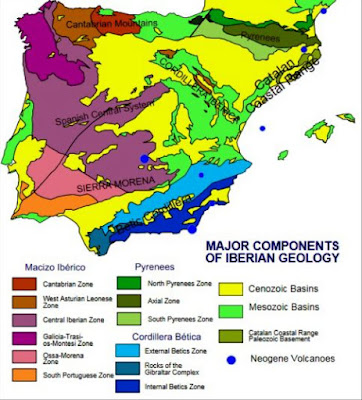Early human history is the record of technological advances. Tools made from stone survive. Geology was the first science.
The earliest have been found in Gona, Ethiopia, located at the northern end of the East African rift valley in the Afar triangle where the Arabian, Somalian and main African plates are pulling away from each other. Olduvai Gorge, which gave its name to the technology, is at the southern end of the valley in modern Tanzania.
Gona tools have been dated to 2.6 million years ago. That’s just before the Gauss-Matuyama reversal in the Earth’s magnetic field at the beginning of the Pleistocene. Many had volcanic origins. Tool makers held a rock with one hand and struck it with another rock held by the other hand. The chips or flakes were the tool, not the diminished stone. Most had an edge on one side. They looked like choppers and scrappers.
The trachytic basalt cobbles were taken from a nearby stream, and carried elsewhere to be worked. The stone workers, usually called flint knappers, selected fine-grained rocks. The fact other rocks were available indicated they had spent time observing stones and remembering the ones with best qualities.
Technology is transportable. Gona’s techniques spread from Africa, where they were used until 1.7 million year ago. Although the above map only shows significant sites in Asia and Europe, Oldowan tools have been recorded in northern Spain after the industry faded from the Rift Valley. Sima del Elefante has artifacts made from chert, quartz, and limestone dated between 1.4 and 1.1 million years. Gran Dolina has quartzite tools from 800,000 years ago.
Both caves are in the Atapuerca formation less than 10 miles east of Burgos. The isolated limestone formation stood above waters running through the Bureba Pass pass between the Cantabrian mountains to the north and the Sistema Iberia abutting from the south during the Cenozoic. It’s the narrow yellow section toward the north on the map below.
The Oldowan quartzite probably came from terraces of the Arlanzón river that flows through Burgos to meet a tributary of the Duero. The Atapuerca chert formed in the later Miocene when silica grew into nodules within the limestone. Flint forms when the limestone is chalky. Limestone is a form of calcium carbonate.
The basalt of Gona and the quartzite and chert of Atapuerca contain silica dioxide (SiO2), the major component in glass and in sand. They break along clear planes with sharp edges, but those planes aren’t visible like they are with mica. Sileshi Semaw believed the ability to fracture them by striking signified a high level of skill and coordination.
Manufacturing techniques and their associated economies survived changes in biology and culture. The earliest bones associated with Oldowan tools were Australopithecus garhi. The modified rocks also have been found with Homo habilis, Homo ergaster, and Homo erectus.
The Gona tools were found along a tributary of the Awash river, upstream and a bit west of Hadar where Lucy, the oldest human ancestor, was found. The Australopithecus afarensis remains are 3.2 million years old. They haven’t been associated with tools.
At Gran Dolina the Oldowan technology was expanded to include chips of different sizes used for different purposes by Homo antecessor. José Bermúdez de Castro’s team believed the species was the immediate ancestor of Neanderthals. While it had the nasal area of the modern species, its jaws and teeth were like those of Homo erectus.
Innovation has two phases. First comes the invention of a technique, then the modification of that idea to fit new circumstances. Both involve a willingness to experiment, an ability to learn from experience, and an expectation of repeatability. Anyone can throw a rock at a boulder to break off a chip, but only a tool maker will watch the arc and aim another to change the outcome to fit a desired end.
Notes:
Bermúdez de Castro, J. M., et alia. "A Hominid from the Lower Pleistocene of Atapuerca, Spain: Possible Ancestor to Neandertals and Modern Humans," Science 276:1392-1395:1997.
Carbonell, Eudald, Paula García-Medrano, et alia. "The Earliest Acheulean Technology at Atapuerca (Burgos, Spain): Oldest Levels of the Galería Site (Gii Unit)," Quaternary International 353:170-194:2014.
Semaw, Sileshi. "The World’s Oldest Stone Artefacts from Gona, Ethiopia: Their Implications for Understanding Stone Technology and Patterns of Human Evolution Between 2.6-1.5 Million Years Ago," Journal of Archaeological Science 27:1197-1214:2000.
____, Jay Quade, et alia. "Paleoenvironments of the Earliest Stone Toolmakers, Gona, Ethiopia," Geological Society of America, Bulletin 116:1529-1544:2004.
Toro Moyano, Isidro, et alia. "The Archaic Stone Tool Industry from Barranco León and Fuente Nueva 3, (Orce, Spain): Evidence of the Earliest Hominin Presence in Southern Europe," Quaternary International 243:80-91:2011.
Graphics:
1. Anonymous map of "Oldowan Sites," uploaded to Wikimedia Commons, 28 October 2010.
2. Efe, PePe. "Geological Units of the Iberian Peninsula," uploaded to Wikimedia Commons, 11 March 2013, translated by Graeme Bartlett.


No comments:
Post a Comment